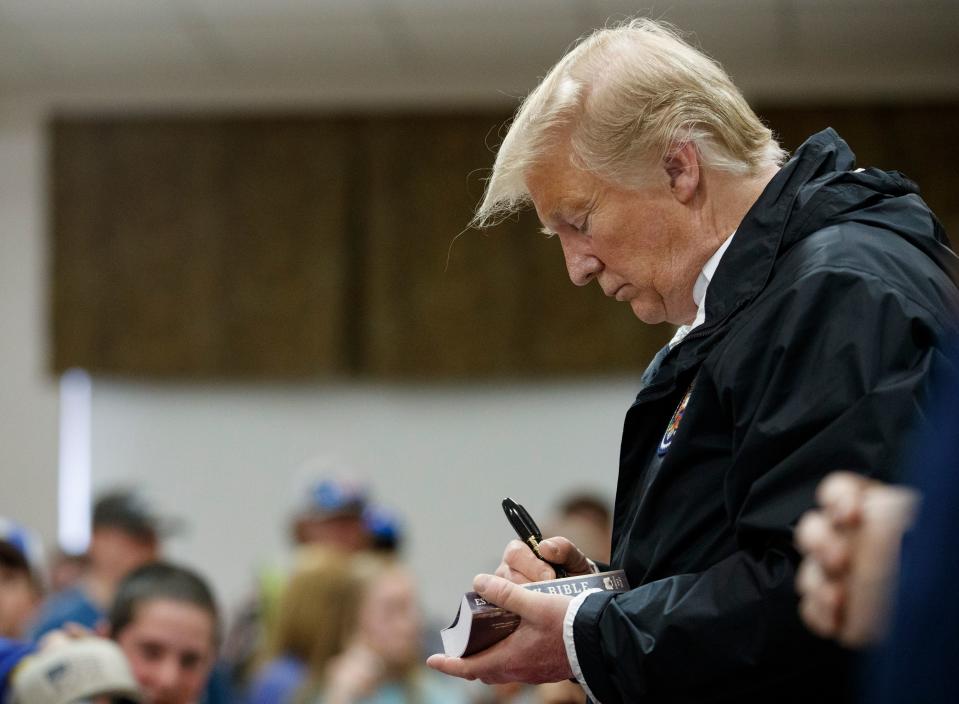'Not a serious proposal': Trump's budget reveals his 2020 message, but Congress will have the last word
WASHINGTON – President Donald Trump called for deep cuts in environmental and safety net programs, billions more for his border wall and a huge boost for the military in a $4.75 trillion 2020 budget proposal that is unlikely to gain traction in Congress.
Trump delivered his first budget under a divided government Monday, a road map that would not balance the books for 15 years despite deep reductions. The proposal also called for $8.6 billion for Trump's border wall, a request Democrats flatly rejected.
"Congress has been ignoring the president's spending reductions for the last two years," Trump's top budget aide, Russell Vought, told reporters when pressed for an explanation about why the budget anticipates a $1.1 trillion deficit next year.
Even before Democrats claimed control of the House, similar proposals by Trump failed in Congress. The schism between the president's wish list and actual government spending only deepened after a dispute over the border wall led to a 35-day partial government shutdown that ended in January.
"This is not a serious proposal," said Sen. Patrick Leahy, D-Vt., the top Democrat on the Senate Appropriations Committee.
Presidential budgets, required by the Budget and Accounting Act of 1921, for decades have had more to do with politics than policy. With the 2020 election underway, the document gives Trump an opportunity to lay out a vision he can trumpet to supporters.
Not your budget: 'Get rid of the fat': Why Uncle Sam's budget is different from yours
What Trump wants
The White House is eager to sell three messages with the president's third budget: that Trump hasn’t given up on building his long-promised border wall, that he wants to increase military spending and that he hopes to slash just about everything else.
The president requested $8.6 billion more for his wall, just weeks after Congress failed to approve his demand for $5.7 billion. With both sides dug in on the issue, the latest proposal is certain to go nowhere. Trump declared a national emergency in February, a move the White House says will free up billions more for the wall.
Trump is also requesting billions more in spending at the Defense Department – one of the few priorities that could gain some attention from lawmakers. After initially considering Pentagon cuts last year, the White House embraced a proposal to increase the Defense Department’s budget 5 percent to $750 billion.
Other proposals include:
• A $2.8 billion, or 31 percent reduction in for the Environmental Protection Agency and a $327 billion cut to safety-net programs. Some of that reduction would be carried out by imposing a work requirement for food stamps, Medicaid and other programs.
• A new user fee on e-cigarettes and other electronic nicotine delivery system products to "address today’s alarming rise in youth e-cigarette use."
• Nearly $315 million to hire an additional 1,000 Immigration and Customs Enforcement officers and 128 immigration court prosecuting attorneys.
• Almost $300 million toward the goal eliminating nearly all new infections of HIV/AIDS within 10 years.
Why it won't happen
Some proposals in Trump's budget could become law, but most of the high-profile items will face tough odds.
Trump has proposed many of the same changes before, without success. Last year’s budget, which came at a time when Republicans controlled both the House and Senate, included $18 billion for the border wall. His 2017 budget proposed eliminating 62 federal agencies entirely. Congress largely ignored those requests and many others.
None of those agencies was eliminated and lawmakers approved only $1.37 billion for border barriers. That partly reflects a politically divided Congress but also the fact that the president's budget has long been viewed as a wish list.
Government printers published about 20,000 hard copies of the president's budget, and a spokesman for the Government Publishing Office says the online version of the document averages about 2 million retrievals each year.
The budget proposal must include information about how much the government collected in taxes and other revenue, the public debt and proposed spending priorities. But the real work of spending taxpayer money is handled by the congressional appropriations process. And that means Democrats and Republicans must work together to decide which programs should be prioritized.
Even some Republicans remained noncommittal about the White House proposal.
“I look forward to reviewing additional details," said Sen. Richard Shelby, R-Ala., the chairman of the Senate Appropriations Committee, "Throughout the next few months, the (committee) will conduct hearings and carefully review the president’s proposal."

This article originally appeared on USA TODAY: 'Not a serious proposal': Trump's budget reveals his 2020 message, but Congress will have the last word

